Learn about some of the most popular sleep training methods to help your baby learn how to fall asleep independently. See the differences between the methods and decide which sleep training method is right for your family.

I think the term sleep training gets a really bad rap. After all, we all potty train our children, meaning we teach them how to use the toilet so they aren’t in diapers forever.
Sleep training isn’t a whole lot different.
Parents use various sleep training methods to help them stop nursing to sleep, moving from room sharing to the crib, and transitioning from SNOO to crib.
As a Pediatric Sleep Consultant, I have walked many families through the process of sleep training their little one and helping their whole family get a good night’s sleep.
If you’re ready to leave sleepless nights behind you, then let’s dive into what sleep training is, why you might consider sleep training your baby or toddler, and the best sleep training methods.
Is your baby struggling with short naps? To help you better, grab my free guide to solving short naps to get practical tips of how to get your baby to take longer naps every single day. Click here to grab it, it’ll be super helpful.

What is Sleep Training?
Sleep training is simply the process of teaching your little one how to fall asleep on her own, and how to sleep for longer stretches at night.
Sleep training is a great way to stop nursing to sleep and weaning night feeds.
There are plenty of misconceptions and mistakes when it comes to sleep training.
Sleep training should be a holistic approach that includes:
- Appropriate baby wake windows
- A consistent bedtime routine
- A nursery that is setup for sleeping
- A sleep training method that fades out the parental presence over time
Many people equate sleep training with cry it out, but there are many different methods of sleep training, ranging from cry it out to more gentle methods that involve gradually reducing the level of assistance provided.
The goal with sleep training is to help babies learn healthy sleep habits, improve their overall sleep quality, and reduce the need for parents to constantly intervene during the night.
When Should You Start Sleep Training?
Wondering when to start sleep training?
You should start sleep training when you feel ready.
Formal sleep training can start as early as your baby hits 4 months or 12 pounds.
At four months, sleep habits aren’t too established and will be easier to break. Before four months old, many babies still have irregular feeds and need to eat in the middle of the night.
Many parents decide to sleep train when they are ready to transition their baby to a crib.
Other times parents sleep train if their baby is going through a sleep regression or they’re dealing with short naps.
Even before you do any sleep training, you can help establish healthy sleep habits like following an eat / wake / sleep routine and avoiding sleep associations.
We followed a modified version of the Babywise method from birth and never had to formally sleep train our daughter.
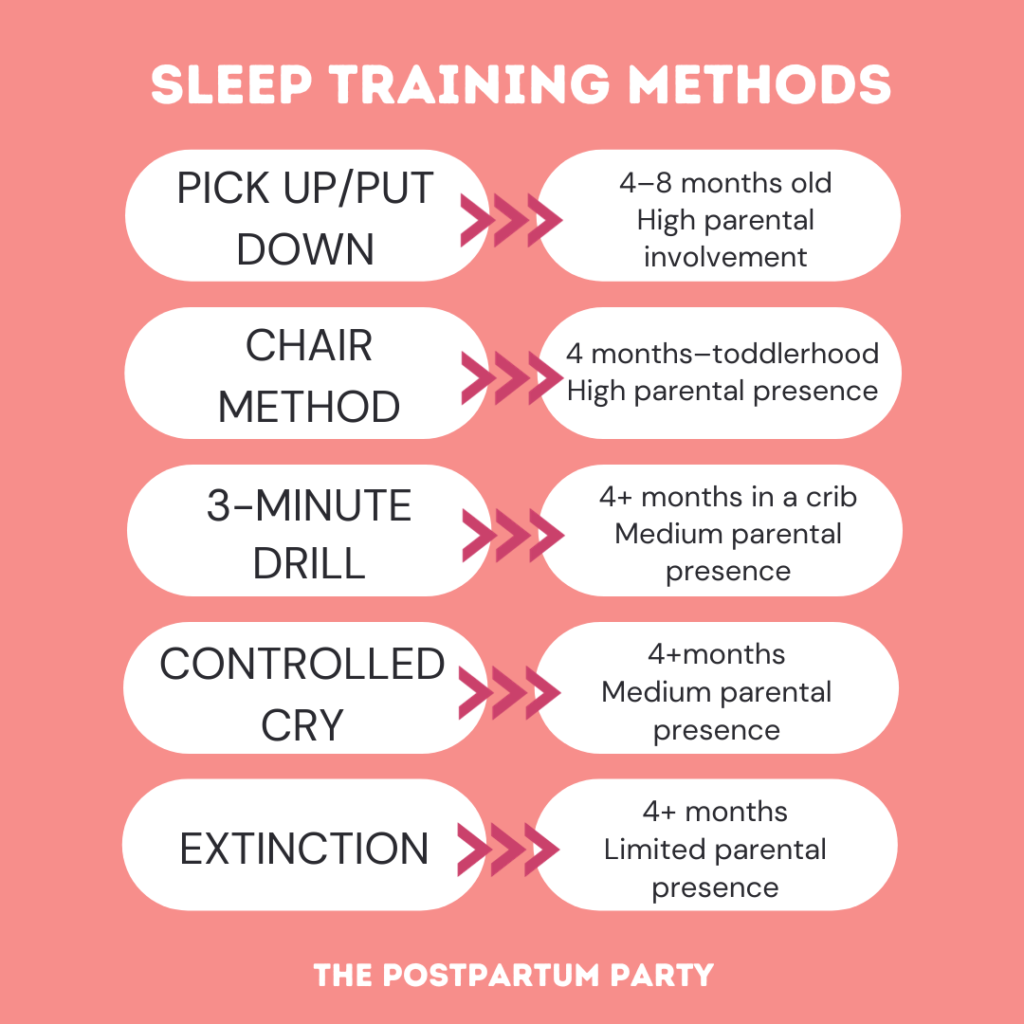
Different Sleep Training Methods
There are multiple sleep training methods out there, each with its own pros and cons.
Some include a parent staying in the child’s room during sleep training, while others have the parent completely out of the room.
Some of them may involve more crying, while other methods are designed to minimize tears.
Let’s explore some of the most popular sleep training methods, including cry it out (extinction), graduated extinction, the Ferber method, bedtime fading, pick-up-put-down, and the chair method.
By understanding the differences between these methods, you can choose the one that is best suited to your baby’s needs and your own parenting style.
Pick Up / Put Down
Ages: Recommended for babies 4–8 months.
The Pick Up Put Down Method is a popular sleep training method founded by Tracy Hogg, the author of Secrets of the Baby Whisperer.
Pick up / put down (PU/PD) is one of the more gentle sleep training methods there is, because you are there to physically comfort your baby by picking her up through the process.
With Pick Up Put Down, you do your baby’s bedtime routine and put your baby in her crib or bassinet while she is still awake.
Once your baby starts crying, you pick her up and comfort her until she calms down or her cry lessens. Once she’s calmed down a little—but not asleep—you put her back in her crib or bassinet.
Keep doing this cycle until your baby falls asleep, picking her up and putting her down as many times as needed.
It can take over 100 pick-ups or up to 2 hours before the child is able to fall asleep, which can be incredibly exhausting for new parents, both emotionally and physically.
However, this method can work really well for very young babies, and parents who want to stay and comfort their child consistently.
The Sleep Lady Shuffle
Ages: Recommended for babies 4 months and up.
The Sleep Lady Shuffle, also referred to as the Chair Method, can be used for babies as young as four months, all the way up to toddlerhood.
It can be especially helpful for toddler sleep training as a way to keep your toddler in their bed at bedtime.
Many parents like using this because it is considered a gentle sleep training method.
With this sleep training method, you physically stay in the room as your child falls asleep, but you aren’t picking her up again and again.
You sit in a chair and will gradually fade your presence out of the room over the course of several days.
Do your typical bedtime routine and put your baby to bed awake. Make sure the room is dark, so your baby can’t see you. Have a chair ready next to your baby’s crib or bassinet.
If your baby starts to cry or fuss, you sit in the chair while she stays in her crib or bed.
Your presence in the chair can help your baby or toddler stay calm in their sleep space and help them fall asleep, knowing that you are there.
You can choose a simple word or phrase to say to help soothe your baby. Something short and simple like, “Shh” or “Mommy’s here” is perfect.
Once your baby falls asleep, you leave the room.
Repeat this same process with the chair in the same spot for three consecutive days. After three days, you gradually move your chair further away.
It’s also a great sleep training method to use when you transition to a toddler bed or in combination with the Pacifier Fairy when you drop the pacifier with your toddler!
The Gentle Three-Minute Drill
Ages: Recommended for babies 4 months and up in a crib.
The gentle-three minute drill is a favorite among many parents and sleep consultants because it allows the parents to be involved, without requiring constant involvement.
This method works well for any baby in a crib and allows for some crying before a caregiver checks in and consoles their baby.
As always, do your bedtime routine and put your baby down for bed while she is still awake.
Leave the room. If your baby cries, listen for the cry to elevate to a loud level-10 cry.
Once your baby starts to cry at this level, start the timer for three minutes.
If at any point during your baby’s cry, she simmers down to a whimper, you stop your timer. You then restart it when the cry elevates to that level-10 cry again.
After three consecutive minutes of that level-10 cry, you can stop the timer and go into your baby’s room and soothe her.
When you go into her room give her a little reassurance and comfort. You can offer a soothing “Shhh” or “Mommy’s here.” You can give her a little pat on her bottom, but try to avoid picking her up from her crib. I know this will be tough, but stick with it!
Keep it short, about 10 to 20 seconds and then leave the room again.
Restart your timer and repeat the process until your baby falls asleep.
Controlled Crying
Ages: Recommended for babies 4 months and up.
Controlled crying is also known as Interval Crying, Ferber Method, or Ferberizing.
It’s been popularized by Richard Ferber’s book, Solve Your Child’s Sleep Problems.
To do Controlled Crying, choose an interval time that you are comfortable with. Common interval options are 5 / 7 / 10 and 5 / 10 / 15.
It’s okay to start on the lower end in the beginning. I have even had some families do 3 / 5 / 7.
Do your typical bedtime routine and put your baby down for bed awake.
Leave the room. Once baby starts crying at that level-10 cry, set your timer for your first interval.
You will go into your baby’s room at the end of the five minutes regardless, unless she has stopped crying or settled down.
After five minutes, go in and reassure your baby. Don’t pick her up but offer her a verbal phrase. Keep your visit short and just offer a quick reassurance, then leave the room again.
This time you will increase your timer. For our example, we’ll now set the timer to 10 minutes. At the end of the 10 minutes, if your baby hasn’t fallen asleep or calmed down, you can go into her room again and do another short reassurance with words.
After you leave her room again, set your timer for the third interval, 15 minutes for this example. If your baby is still crying after 15 minutes, go into her room for a short reassurance again.
Reset your timer to 15 minutes and offer quick reassurance after 15 minutes each time.
Cry It Out / Extinction Method
Ages: Recommended for babies 4 months and up.
Cry it out, also known as extinction method, is the least gentle of the sleep training methods.
Some may consider it cruel, but for others, the crying is short and works quickly.
This method typically involves the most crying and has the least amount of parental presence.
Extinction sleep training is simple to follow, but can be very emotionally difficult on the parents. You follow your same bedtime routine with your baby and then put her to bed and leave the room. You don’t return until the morning.
Some babies will stop crying quickly and fall asleep, while others may cry for very long periods of time. This is usually the last-resort for sleep training, when other methods haven’t worked.
Which Sleep Training Method is Best?
There is no one-size-fits-all approach when it comes to parenting.
We all have unique personalities, and our little babies are no different. Even from a very young age, babies have different temperaments and will respond better to certain methods over others.
The best sleep training method for you will depend on your baby’s temperament, as well as your personality as a parent.
In addition to your baby’s personality, you should consider your preference when sleep training.
Is hearing your baby cry for long periods of time really difficult for you? Do you want to stay in the room to help soothe your baby through the sleep training process.
It’s a good idea to choose a sleep training method that you and your partner are comfortable with and can sustain over the course of 2 to 3 weeks.
What is the Most Effective Sleep Training Method?
There is no one-size-fits-all answer to what the most effective sleep training method is.
Every baby (and parent) is different, and will respond differently to different approaches.
Some parents find Check and Console methods to be very effective in quickly teaching babies to self-soothe, while others prefer the more hands-on approach of the Chair Method.
Ultimately, the effectiveness of a sleep training method depends on several factors, including your baby’s age, temperament, routines, and consistency.
It’s important for parents to choose a method that aligns with their values and beliefs, and to be extremely consistent in implementing the method.
What Age is Easiest to Sleep Train?
There are pros and cons to sleep training at any age.
Some things will be easier about sleep training a younger baby and some things will be easier about sleep training a toddler.
It’s important to consider your own readiness for sleep training. Starting sleep training too early or before you feel prepared can lead to unnecessary stress and frustration for both you and your baby.
Make sure to take your own comfort level into account when deciding when to sleep train.
Tips for Successful Sleep Training
There is so much more to sleep training than just choosing a method. Sleep training is a holistic approach, and you likely won’t see success unless you have all the elements working together.
Here are tips for successful sleep training, in addition to choosing your sleep training method.
Create a conducive sleep environment
One of the easiest things to do before sleep training is create an environment that is conducive for sleep.
Some things you can do to create a good sleep environment include keeping the room dark, quiet, and cool, using white noise to drown out any outside noise, and using blackout curtains to prevent any outside light from coming in.
Follow Your Baby’s Sleep Schedule
When doing any of these sleep training methods, make sure you’re following your baby’s proper wake windows and that you aren’t putting your baby to bed overtired.
Establish a bedtime routine
Establishing a consistent bedtime routine for your baby can be so helpful when sleep training. A bedtime routine helps signal to your baby that it is time for sleep.
A bedtime routine can consist of 3 to 5 activities that helps your baby get ready for bed, such as a bath, books, and a song. The key is to keep the routine consistent every night, so your baby starts to know what to expect and associates their routine with sleep.
Start At Night
Sleep train first at bedtime and then start sleep training for naps after bedtime starts getting easier.
Be consistent
Consistency is key when it comes to sleep training. Once you have established your sleep training method and bedtime routine, stick with it.
Consistency can help your baby learn what is coming next and help them develop healthy sleep habits.
Monitor your baby’s progress
It’s easy to get discouraged, but map out your progress so that you can measure data and see how things are going. Sleep training won’t always be linear, but you should see general forward progress over a few weeks.
Be Patient
Sleep training can take time, so be patient and remember that every baby is different. How long sleep training takes depends on your baby’s temperament, the method chosen, and consistency.
Common Concerns About Sleep Training
Many parents have concerns about sleep training, such as whether it is harmful to baby, or if it will affect attachment. However, research shows that sleep training is safe and does not harm babies.
In fact, many parents find that their bond with their baby actually improves once they start getting better sleep.
Sleep training can be a challenging process, but it can also be incredibly rewarding.
By picking the right sleep training method for your family and staying consistent, you can help your baby learn to fall asleep on their own and get everyone better sleep.
Get Better Sleep with The Baby D.R.E.A.M. System
If you want someone to walk you through the process of sleep training, let me help. The Baby D.R.E.A.M. System is for babies 4 months through 2.5 years old. I’ll walk you through how to establish daily routines, sleep schedules, and sleep training techniques to help you break the sleep associations you no longer find beneficial! Check it out here.
Questions about any of these sleep training methods? Leave them in the comments and we’ll help you out.
- Newborns and Swaddling (Safety Tips) - March 19, 2024
- 25 Baby’s First Christmas Ornament Ideas - March 18, 2024
- Baby’s First Christmas Ornament DIY from Birth Announcement - March 18, 2024
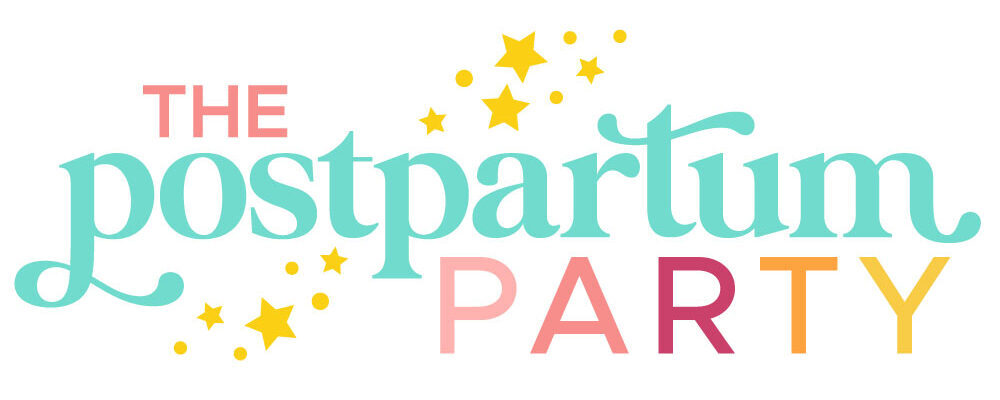




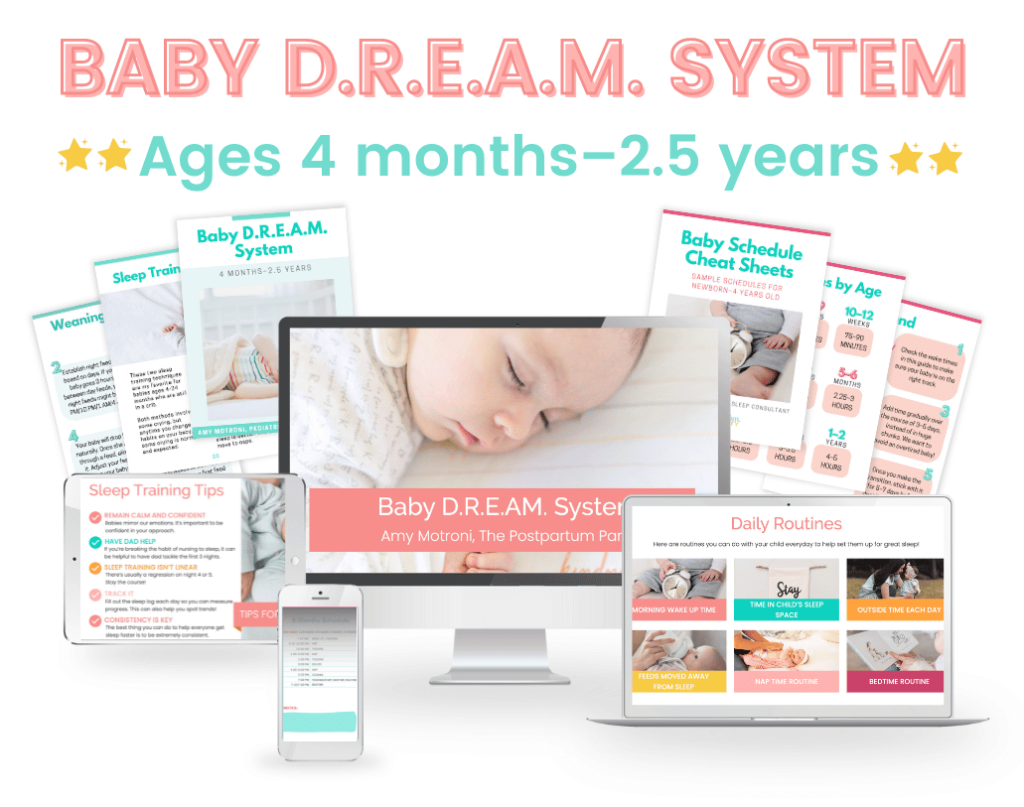



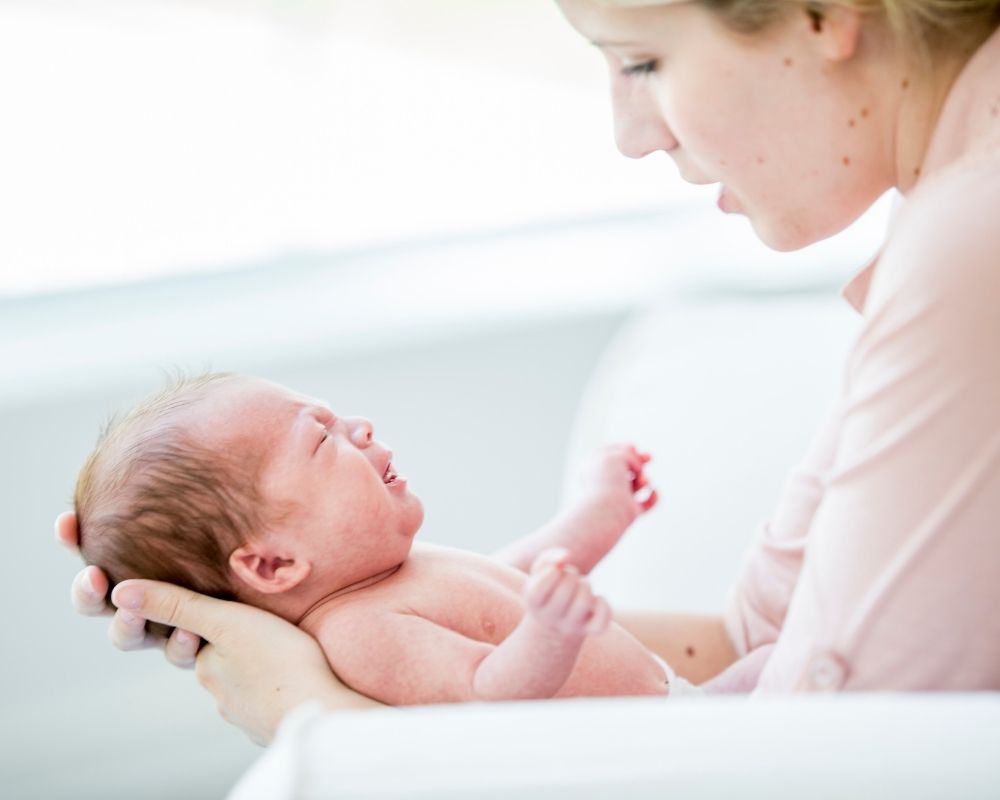

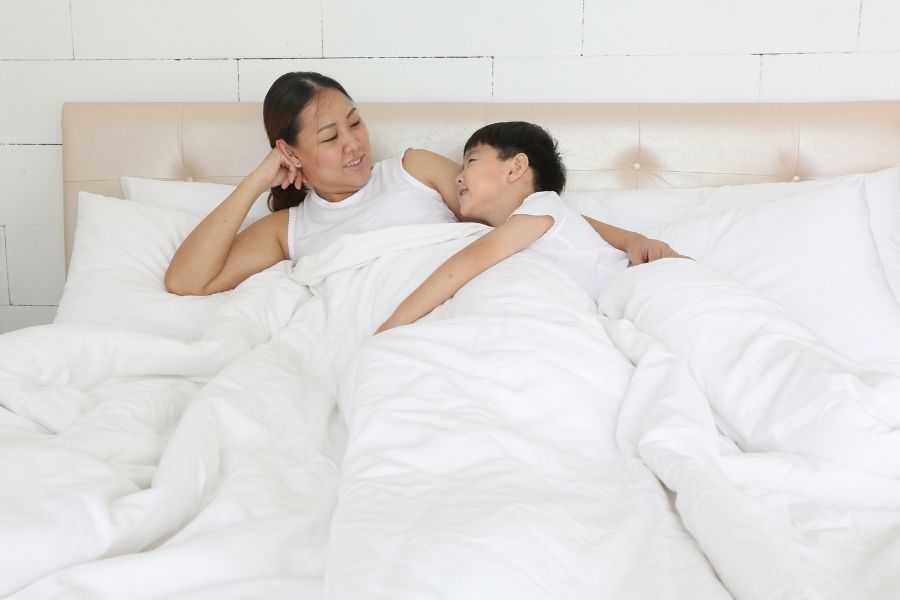
One Comment